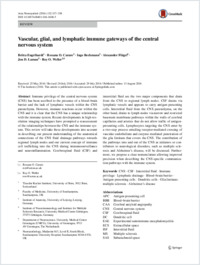Vascular, glial, and lymphatic immune gateways of the central nervous system.
- Engelhardt B Theodor Kocher Institute, University of Bern, 3012, Bern, Switzerland.
- Carare RO Faculty of Medicine, University of Southampton, Southampton, UK. rcn@soton.ac.uk.
- Bechmann I Institute of Anatomy, University of Leipzig, Leipzig, Germany.
- Flügel A Institute of Neuroimmunology and Institute for Multiple Sclerosis Research, University Medical Centre Göttingen, 37073, Göttingen, Germany.
- Laman JD Department of Neuroscience, University Medical Center Groningen (UMCG), University of Groningen, 9713 AV, Groningen, The Netherlands.
- Weller RO Faculty of Medicine, University of Southampton, Southampton, UK. row@soton.ac.uk.
- 2016-08-15
Published in:
- Acta neuropathologica. - 2016
Alzheimer’s disease
Antigen-presenting cells
Blood–brain barrier
CNS
CSF
Dendritic cells
Glia limitans: multiple sclerosis
Immune privilege
Interstitial fluid
Lymphatic drainage
Alzheimer Disease
Animals
Central Nervous System
Extracellular Fluid
Humans
Lymph Nodes
Nervous System Diseases
Neuroglia
English
Immune privilege of the central nervous system (CNS) has been ascribed to the presence of a blood-brain barrier and the lack of lymphatic vessels within the CNS parenchyma. However, immune reactions occur within the CNS and it is clear that the CNS has a unique relationship with the immune system. Recent developments in high-resolution imaging techniques have prompted a reassessment of the relationships between the CNS and the immune system. This review will take these developments into account in describing our present understanding of the anatomical connections of the CNS fluid drainage pathways towards regional lymph nodes and our current concept of immune cell trafficking into the CNS during immunosurveillance and neuroinflammation. Cerebrospinal fluid (CSF) and interstitial fluid are the two major components that drain from the CNS to regional lymph nodes. CSF drains via lymphatic vessels and appears to carry antigen-presenting cells. Interstitial fluid from the CNS parenchyma, on the other hand, drains to lymph nodes via narrow and restricted basement membrane pathways within the walls of cerebral capillaries and arteries that do not allow traffic of antigen-presenting cells. Lymphocytes targeting the CNS enter by a two-step process entailing receptor-mediated crossing of vascular endothelium and enzyme-mediated penetration of the glia limitans that covers the CNS. The contribution of the pathways into and out of the CNS as initiators or contributors to neurological disorders, such as multiple sclerosis and Alzheimer's disease, will be discussed. Furthermore, we propose a clear nomenclature allowing improved precision when describing the CNS-specific communication pathways with the immune system.
- Language
-
- English
- Open access status
- hybrid
- Identifiers
-
- DOI 10.1007/s00401-016-1606-5
- PMID 27522506
- Persistent URL
- https://folia.unifr.ch/global/documents/166916
Statistics
Document views: 11
File downloads:
- fulltext.pdf: 0
